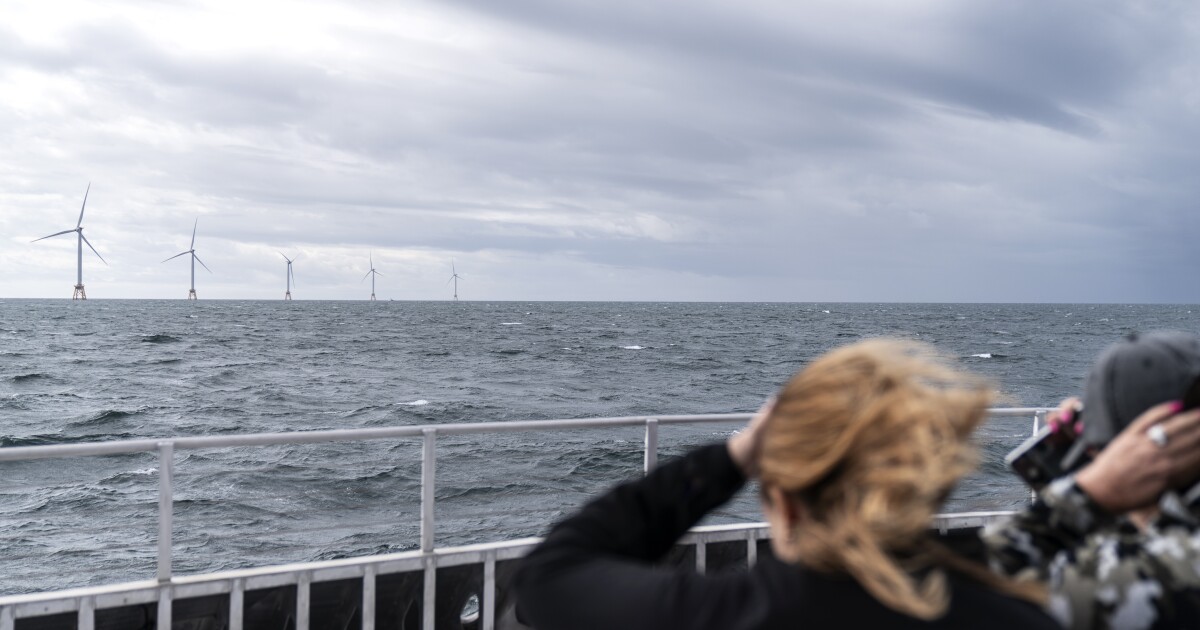

California officials are looking to expand offshore wind farms — a pricey but valuable resource that could play a key role in reaching 100% clean energy in the future.
Gov. Gavin Newsom (D-CA) signed the most ambitious strategic plan in September 2021, with the California Energy Commission introducing its proposal last summer of building 5 GW of offshore floating wind power generation by 2030 and 25 GW by 2045 — enough power to support around 25 million homes.
INFLATION HOLDS STEADY AT 3.4% IN SEPTEMBER IN FED’S PREFERRED GAUGE
“We are at an exciting inflection point for floating offshore wind development in the United States, where federal, state, and industry leadership now is poised to foster a new reliable and sustainable clean energy resource,” Jocelyn Brown-Saracino, offshore wind energy lead for the U.S. Department of Energy, told the Washington Examiner. “And California’s offshore wind targets for the state’s coastal waters, coupled with the successful federal lease auctions, are setting the stage for the West Coast to become a global hub for floating offshore wind expertise and manufacturing.”
Working toward that target, Newsom signed a number of climate laws this session, including some to fast-track building the state’s first offshore wind farms. Newsom made a deal with Democratic legislators that would allow California’s Department of Water Resources to sign long-term electricity contracts to purchase from offshore wind facilities on behalf of all Californians. Under Assembly Bill 1373, sponsored by Democratic Assemblyman Eduardo Garcia of Coachella, the DWR can act as a centralized procurement entity until Jan. 1, 2035.
The State Director of Environment California, Laura Deehan, who campaigns for offshore wind development and sponsored some of the passed bills, told the Washington Examiner that this new bill gives the state’s DRW “the power to do specific procurement for any clean energy that takes a while, like offshore wind or geothermal or long duration storage.”
“Because offshore wind is a longer lead time energy source, it takes just longer to build a project,” Deehan said. “It’s actually really hard for some entities to order that energy source.”
Assembly Democratic Caucus Chairman Rick Chavez Zbur authored Assembly Bill 3, the Offshore Wind and Jobs Act, which aims to improve offshore wind energy projects in-state, enhancing seaport readiness so California can become a hub for the wind manufacturing sector.
Deehan said there is a lot of heavy lifting needed to expand those ports
“In order to get giant turbines turning offshore, we’re going to need to do a lot of upgrades to California’s ports, which is where the turbines are gonna have to be launched out to sea, where all the maintenance crews are gonna be working, where there’s gonna be transmission lines that will come on shore,” Deehan said. “So we’re gonna need to do a lot of work to basically expand those ports so that they can handle some of these new needs.”
Newsom also signed Senate Bill 286, another step forward in the process for new offshore wind development. SB 286 streamlines the state’s offshore wind permitting process by designating the State Lands Commission (SLC) as the lead agency for California Environmental Quality Act in order to protect groups who may be affected by wind projects.
“This bill will expedite the state-side offshore wind permitting process eliminating a staggering 5 years off of the permitting timeline all while protecting California’s coastal environment and storied fishing fleet,” Democratic state Senate President Designee Mike McGuire, the sponsor, said in a statement.
Deehan said the group has been collaborating for years with state lawmakers, officials, and other environmental groups to push forward new offshore wind laws.
“We have the technology, we have the potential, to be able to capture the wind and use that power to generate electricity that could power everything in our society — it’s just this incredible opportunity,” Deehan said.
Deehan said that wind power off the California coast could be used to meet all power needs in the future, as the state has seen a dramatic growth of renewable energy in recent years.
“We’re talking 25 miles offshore, the wind is blowing so hard and so fast and it is an incredibly powerful potential source of energy,” Deehan said.
The future for offshore wind gained momentum last December when the first leases were awarded to two federally designated wind areas. The federal government auctioned off leases for 583 square miles of ocean waters off Humboldt County and Morro Bay at the end of 2022, and leaseholders have been working meticulously to get their projects off the ground, hoping the slew of offshore wind legislation this session will fast-track things.
Officials are using their resources to address concerns of how to best protect marine life during the construction of offshore wind farms and learning from other countries that are further along in the process, such as Europe and China.
“California is like this biodiversity hotspot,” Deehan said. “We have incredible wildlife living offshore. A lot of people are justifiably worried about what would this brand new, new industry in the ocean mean for wildlife.”
CLICK HERE TO READ MORE FROM THE WASHINGTON EXAMINER
Deehan added a wildlife research hub on the West Coast is in the works, aiming to provide resources to scientists to monitor the effects on marine life.
“One of the things that’s been a very big priority for Environment California, and for a lot of other environmental and conservation groups, has been making sure that conservation and wildlife are top of mind as our state is planning to get to our offshore wind goals,” Deehan said.





